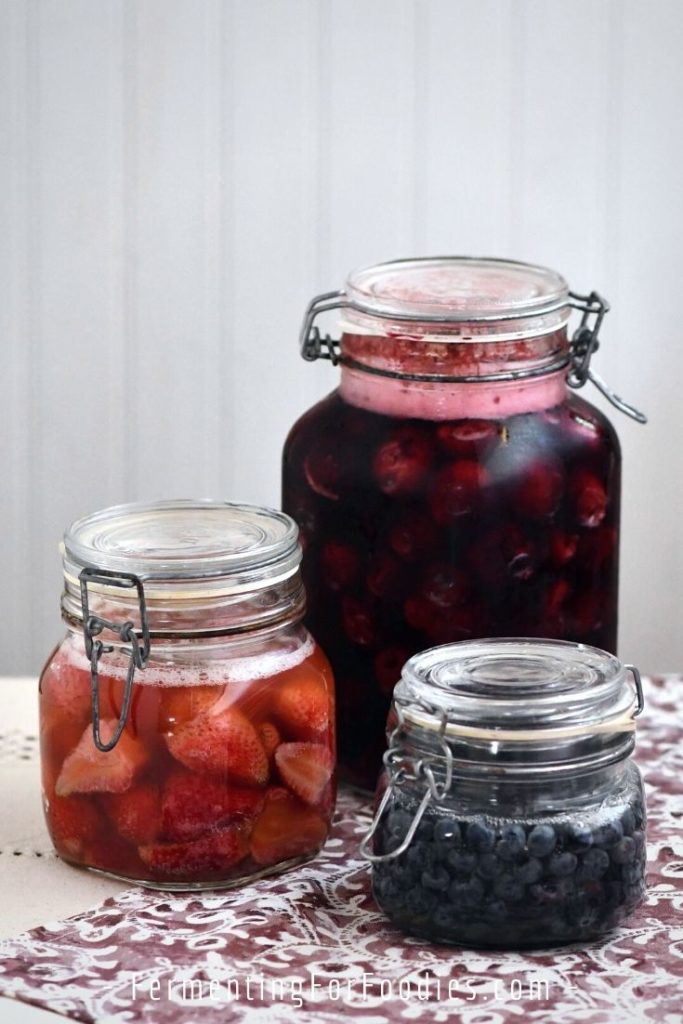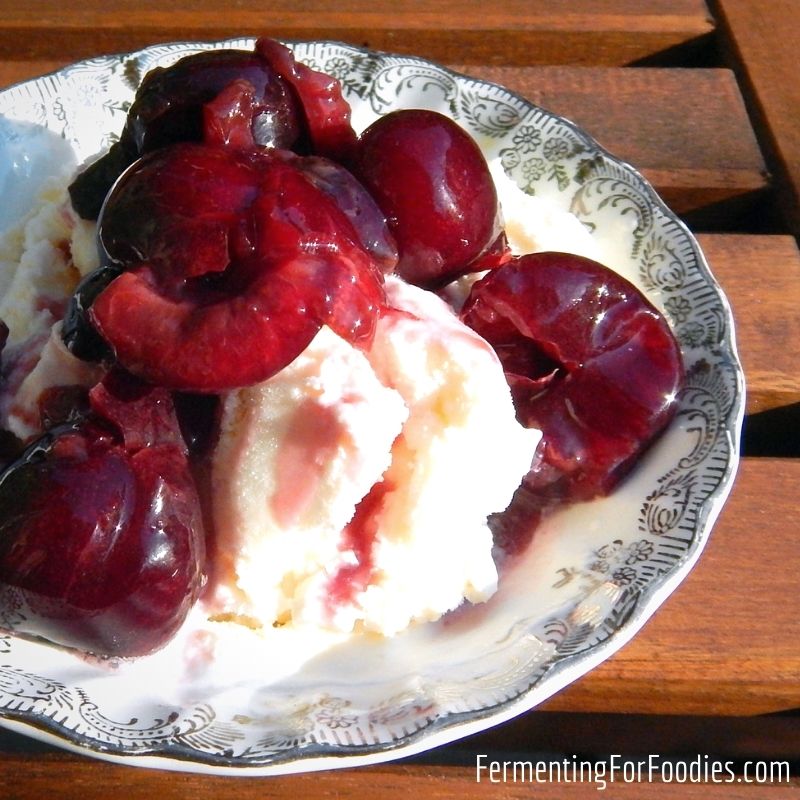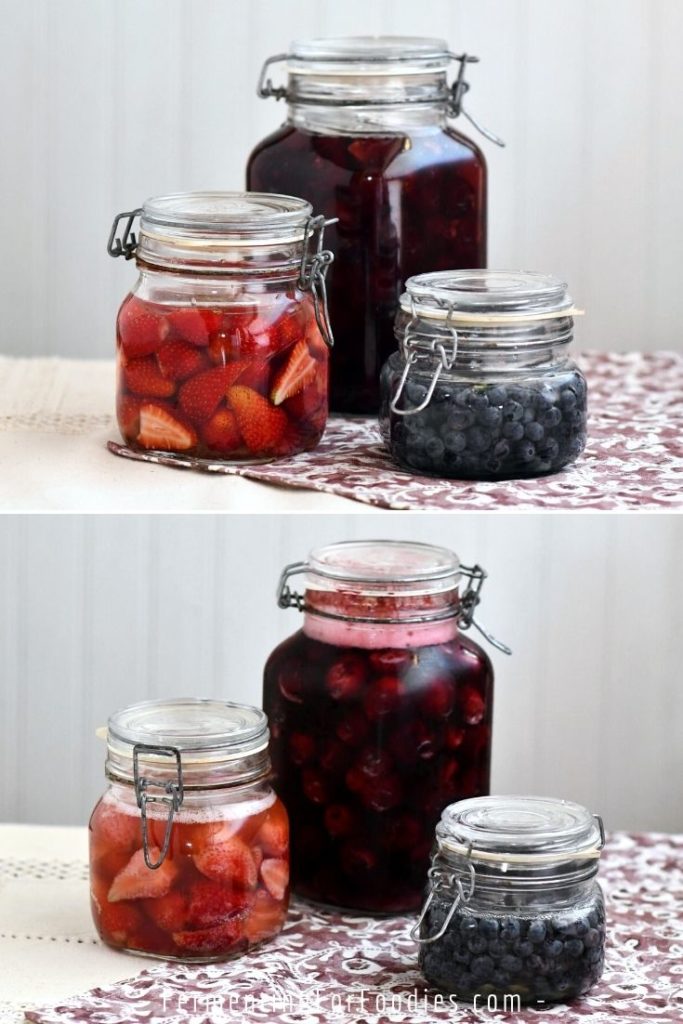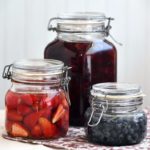Spring and summer is fresh fruit season. And it always arrives with abundance. Making fermented fruit is my favorite way to preserve fruit for winter.

This simple recipe will work with any combination of fruit: blueberries, blackberries, raspberries, strawberries, and cherries. It works for peaches, plums, or apricots as well!
- It’s so quick, easy, and delicious.
- A zero-waste, energy-free way to preserve fruit.
- It’s low-sugar and probiotic!
Fruit Preserves on Everything
Sweet fermented fruit
A fresh jar of fermented berries is so easy to use. It’s a probiotic and low-sugar (or sugar-free) alternative to jams and sweetened fruit sauces. It is a delicious treat served straight up in a bowl with a spoon. Sweet berries are an ideal topping for pretty much everything:
- Oatmeal
- Yogurt
- Sourdough Pancakes
- Waffles
- Ice cream
- Granola

Savory pickled fruit
If left to ferment for more than 7 days, the fruit will become savory and slightly acidic. They are more like a pickle than a sweet ferment.
- They are great as a condiment served with a traditional meat and potatoes meal.
- Served in salads (with goat cheese and pecans, yum!).
- As a unique pizza or pasta topping.

Storing fermented fruit
Fermented fruits will last in the fridge for 1 month without any issues. It may even last for longer… but it will continue fermenting becoming less and less sweet over time.
The best way to store fermented fruit for winter eating is by freezing it. Here are some tips and tricks:
- Use straight-sided mason jars.
- After fermenting, put on a screw cap and place the jar in the freezer.
- It will remain delicious and probiotic for up to 6 months!
- Simply defrost it in the fridge and use it however you want.
Simple Fermented Fruit
Fermenting fruit is a great way to preserve the delicious flavors of summer. It is perfect with any combination of berries or soft fruit. See the section above for sweet and savory serving options.
- Prep Time: 10 minutes
- Total Time: 10 minutes
- Yield: 2 cups 1x
- Category: Dessert
- Method: Fermented
- Diet: Vegan
Ingredients
- 2 cups of fresh fruit or berries (no bruises or bad spots)
- 2 Tbsp of starter culture (see notes for some suggestions)
- Water, enough to cover (chlorine-free)
- 1 Tbsp raw sugar (optional, to feed the ferment)
Instructions
- Wash and prepare the fruit. If you are using stone fruit then you need to pit and slice them. Large strawberries should be sliced as well.
- Pack the fruit into a glass jar for fermenting.
- Stir in the sugar and culture.
- Add enough filtered water to keep the fruit submerged, leaving at least 1 inch of headroom at the top of the jar.
- Use a weight to keep the fruit below the liquid. Cap with a fermentation-friendly jar lid or a cloth held in place with a jar ring to keep out any fruit flies. It’s going to bubble a lot, so don’t use a tight lid.
- Place the jar in a cool dark location (a cupboard is perfect) to ferment for 2-3 days.
- The fruit will start out “sparkling” but it should mellow out after a few days in the fridge.
- If you want a smooth sauce, without any chunks, then puree after fermenting.
- The fruit will be a lot less sweet than you expect. Even if you used honey as the culture, fermenting consumes most of the sugars. If you want your fruit to be a bit sweeter, stir in sugar or honey right before serving.
- Store the fruit in the fridge and enjoy them within 2 weeks. See the section above for details on how to preserve fermented fruit for winter eating.
Notes
- The natural sugars in the fruit will ferment with any yeast-based culture. Try using water kefir, kombucha, milk kefir whey, or ginger bug. Raw apple cider vinegar is perfect for a savory ferment. My favorite culture is raw (unpasteurized) honey which naturally ferments into a sweet, then savory combination.
- I usually ferment in a straight-sided 500 ml mason jar
which makes it easy to freeze them after fermenting. Regardless it’s important to keep the fruit below the liquid because there is an added risk of mold contamination with a sweet ferment.





This looks great! So there’s no salt? And is there any problem with doubling in a 1000 mL Jae? I’m new-ish to fermenting and just want to double check.
It’s not a salt based ferment. Salt is good to protect a ferment, however, fermenting for just a few days ensures that it doesn’t go yeasty or moldy! I actually do it in a quart sized jar normally. 🙂
This sounds amazing! Can’t wait to try!
Would using frozen berries that are thawed work in this recipe by chance? Thanks!
Yes! Just make sure to use a very active culture as the frozen berries probably won’t have any wild yeasts on their skins. Good luck!
We used this with our morning pancakes. The kids love the texture that the chia gives. Awesome!
Great! My kids love it too!
Bu ve benzeri meyve ve şekerli fermente içeceklerde alkol oluşuyor mu?
Anlayışına teşekkür ederim Emillie..
Yes… however, milk kefir and kombucha usually can’t handle alcohol levels of more than 1%. If you added winemaking yeast, then you would definitely end up with more alcohol! Though still not that much as there isn’t enough added sugar to ferment to a high alcohol level.
This is amazing! I made it and then got preoccupied and left it in the fridge for a few weeks. One day I was eating plain Greek yogurt and decided to put some in it (I made it with raspberries) and OMG!!! I will be making this with blueberries and blackberries next! It is absolutely delicious. Thank you❤️
Glad you enjoyed it!
Hiya
If I wanted to use raw honey as the culture, how much should I add?
Would the honey alone be able to ferment the berries?
Thank you! Look forward to your reply.
Eliza
Yes! Raw honey is great at fermenting fruit. Using 2 Tbsp of raw honey will be enough to ferment the berries. Don’t add the sugar, and use up to 4 Tbsp if you want it to taste sweet. Raw honey tends to quickly ferment and is much less sweet than you would expect. Enjoy!
Thank you Emillie for your reply 🙂
I had no idea that raw honey could be used it such a way! I’m so excited to try it out and see what magic happens – just made my first jar. I’m using wild blackberries from the countryside.
Wish me and my blackberries luck! I have a feeling that this will become a family tradition.
Many thanks
Eliza
I know it will work! I have a few other honey fermented recipes on the site. It’s always hard to know which culture to suggest for recipes like this. 🙂 It will be really bubbly, so keep an eye on it. Enjoy!
I read in your notes you use honey for your culture so I don’t have to use whey right ?
Yes! I’ve used all sorts of different cultures… it mostly depends on what is handy in my kitchen. Cheers!
Great I’ll make it right now!
Thanks
Just didn’t find where in the recipe is a Chia seeds because I saw in one of the comments that someone said the Chia makes a great texture, but I couldn’t find this year where it goes
I use chia seeds to thicken it, like jam. But only after fermenting… and only if that’s the condiment I’m looking for. Enjoy your fermented berries!
Do you know if this will create an alcoholic ferment? Like actual wine, or more like kombucha levels, or alcohol free?
Great question! Yeast always converts sugar into alcohol. However, unless you use straight yeast (like bread yeast or brewing yeast) it will be low in alcohol. If you use ACV and let it ferment until it is quite vinegary, then it will be nearly alcohol-free. The acetic acid bacteria in ACV converts alcohol into acetic acid. Cheers!
How much ACV would I use for a one quart jar?
I typically use 1/4 cup ACV in a quart-sized jar. Enjoy!
Can I keep adding more raspberries to honey fermented raspberries? I’m getting around 70g a day from my canes. My original fermented jar has a lot of juice, so space for more and wonder if I can keep topping up?
Wow, that sounds amazing! I wish I had some of your canes. 🙂 I’m concerned with you adding more raspberries to an existing ferment. Each time you do that, it has the potential of introducing unwanted mold, yeast, etc. Also, ferments have a cycle they go through of really active fermenting, which slows down as it acidifies.
I recommend doing a few different batches instead. Then you can play with different cultures (like ACV or wild yeast, which does quite well with soft fruit). You can also try different flavors… like adding a bit of lemon zest or mint to your raspberries. Cheers!
Thank you, for your response. I had a feeling it wouldn’t be a good idea, so glad I held off. I will try your suggestions though, especially the mint as I have some growing already.
Yum! We did raspberry mint this year and loved it in salad dressings.
I made this with home grown raspberries, it turned out great!
So glad! Thanks for sharing.
I am wondering if mangoes are good to ferment? It’s not the right season for soft fruits and a need a break from my very demanding apple tree.
Yes! You can ferment mangos following this recipe if you want. 🙂 In my cookbook, I have a fermented mango chutney that is amazing (one of my fav recipes from the book). That recipe isn’t online, but you can likely borrow the book from your local library. Enjoy! Emillie
Thank you! Clearly need to buy your book. I have enjoyed trying out your other ferments so far
Thanks!
is this safe for a 10 month old if honey is used? I know they can’t have it but is it all lost during fermenting?
I don’t recommend honey ferments for babies or anyone who should avoid raw honey. Fermenting does reduce the risk of botulism (as the honey becomes more acidic). But the risk isn’t completely gone unless you test the pH. Also, fermenting honey also creates alcohol (like mead). It won’t be highly alcoholic unless you add sugar. However, it’s still probably more than you’d want to give your baby.
Be well, Emillie